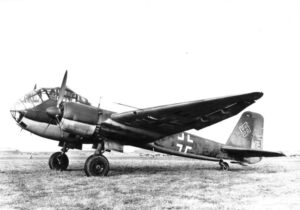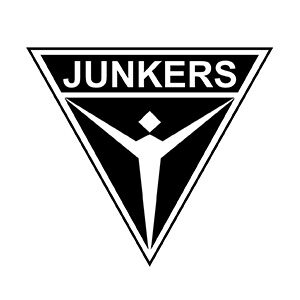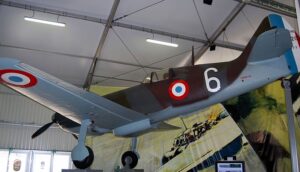Time Period: World War II
Country of Origin: Germany
Type: Bomber Aircraft, Reconnaissance and Surveillance
Manufacturer: Junkers
Junkers Ju 87 Aircraft Overview
The Junkers Ju 87, commonly known as the Stuka (from Sturzkampfflugzeug, meaning “dive bomber” in German), was a German dive bomber and ground-attack aircraft used during World War II. It played a crucial role in the early stages of the war, especially during the Blitzkrieg campaigns in Poland and Western Europe.
Key features of the Junkers Ju 87 Stuka include:
-
Dive-Bombing Capability: The Stuka was specifically designed for precision dive-bombing attacks. Its distinctive design included a fixed undercarriage, inverted gull wings, and a siren called the “Jericho Trumpet” on its landing gear, which produced a distinctive and intimidating wailing sound during dives.
-
Armor Protection: The Stuka was equipped with significant armor protection for the crew, especially around the cockpit and engine areas, providing a degree of defense against enemy anti-aircraft fire.
-
Stabilized Dive System: The Stuka featured an automatic pull-out system that ensured the aircraft would automatically recover from a dive after releasing its bombs. This allowed for accurate targeting and reduced the vulnerability of the aircraft during the attack.
-
Versatility: While primarily used as a dive bomber, the Stuka could also be adapted for other roles, including anti-tank missions and close air support for ground forces.
-
Early Successes: The Ju 87 played a prominent role in the Blitzkrieg tactics employed by the German military during the early stages of World War II. It was highly effective in disrupting enemy defenses and demoralizing ground troops.
However, as the war progressed, the Stuka faced increasing challenges due to advancements in enemy air defenses and the development of more agile and faster fighter aircraft. Its vulnerabilities became apparent during the Battle of Britain, where losses were significant.
Despite its later limitations, the Junkers Ju 87 Stuka remains a symbol of the early successes of the German Luftwaffe and the Blitzkrieg tactics that characterized the early phases of World War II.
Junkers Ju 87 Specifications
- Crew: 2
- Length: 11.5 m (37 ft 8.75 in)
- Wingspan: 13.8 m (45 ft 3.5 in)
- Height: 3.9 m (12 ft 9.25 in)
- Wing area: 31.9 m2 (343.37 sq ft)
- Airfoil: Göttingen 256
- Empty weight: 3,900 kg (8,598 lb) (equipped)
- Max takeoff weight: 6,600 kg (14,550 lb)
- Powerplant: 1 × Junkers Jumo 211J V-12 inverted liquid-cooled piston engine, 1,000 kW (1,400 hp) for take-off. 1,050 kW (1,410 hp) at 4,300 m (14,100 ft)
- Propellers: 3-bladed Junkers constant-speed propeller
Junkers Ju 87 Performance
- Maximum speed: 410 km/h (255 mph, 222 kn) at 4,100 m (13,500 ft)
- Cruise speed: 319 km/h (198 mph, 172 kn) at 5,100 m (16,700 ft)
- Range: 1,535 km (954 mi, 829 nmi) at 5,100 m (16,730 ft) (maximum)
- Service ceiling: 7,300 m (24,000 ft)
- Time to altitude: 5,000 m (16,400 ft) in 20 minutes.
Junkers Ju 87 Armament
- Guns: 2 × 7.92 mm (0.31 in) MG 17 machine guns forward firing, 1 × 7.92 mm (0.31 in) twin MG 81 machine gun to rear
- Bombs: 1 × 250 kg (550 lb) bomb beneath the fuselage and 4× 50 kg (110 lb) under-wing.
Junkers Ju 87 Image Gallery
More Junkers Aircraft

Junkers Ju 52 Tante Ju
The Junkers Ju 52 was a German transport aircraft designed by Junkers used as both an airliner and deployed during World War II.

Junkers Ju 88
The Junkers Ju 88 was a German Luftwaffe twin-engined multirole combat aircraft introduced in 1939 and used widely during World War II.

Junkers Ju 188 Rächer
The Junkers Ju 188 Rächer was a German high-performance medium bomber used by the Luftwaffe during World War II.
More Luftwaffe Aircraft
The Luftwaffe, the German air force during World War II, fielded a diverse range of aircraft that played critical roles in the conflict. These aircraft encompassed fighters, bombers, reconnaissance planes, transport aircraft, and more. Explore others:

Blohm & Voss BV 141
The Blohm & Voss BV 141 (originally known as the Ha 141) was an asymmetrical World War II German tactical reconnaissance aircraft.

Blohm & Voss BV 222 Wiking
The Blohm & Voss BV 222 Wiking was a large six-engined German flying boat originally developed during the late 1930s as a commercial venture.

Blohm & Voss BV 138 Seedrache
The Blohm & Voss BV 138 Seedrache was a trimotor flying boat used by the Luftwaffe for seaborne maritime patrol and naval reconnaissance.

DFS 230
The DFS 230 was a German transport glider developed in 1933 and operated by the Luftwaffe during World War II.

Focke-Achgelis Fa 223 Drache
The Focke-Achgelis Fa 223 was a helicopter developed by Germany during World War II and the first one to attain production status.








